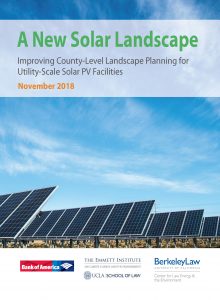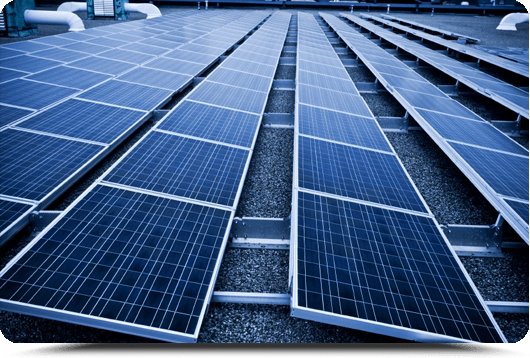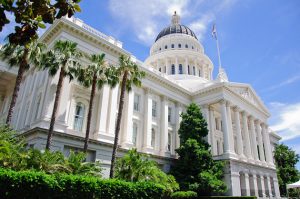Tag Archives: SB 100
 UC Berkeley and UCLA Schools of Law are today releasing a new report, A New Solar Landscape, which identifies key reforms for California to enact at the state, regional, and local level to increase the pace and optimal siting of utility-scale solar photovoltaic (PV) development. With the passage of SB 100 (de León, 2018), California now requires electric utilities to obtain 60 percent of their electricity from renewable sources by 2030 and 100% carbon-free electricity by 2045. To meet these goals, the report recommends that state leaders:
UC Berkeley and UCLA Schools of Law are today releasing a new report, A New Solar Landscape, which identifies key reforms for California to enact at the state, regional, and local level to increase the pace and optimal siting of utility-scale solar photovoltaic (PV) development. With the passage of SB 100 (de León, 2018), California now requires electric utilities to obtain 60 percent of their electricity from renewable sources by 2030 and 100% carbon-free electricity by 2045. To meet these goals, the report recommends that state leaders:
- Encourage development of county-level landscape plans by linking them to incentives like expedited review under the California Environmental Quality Act.
- Ensure that project benefits flow first to communities most immediately affected by development.
- Increase support for transmission infrastructure located in areas appropriate for solar development.
- Create a consolidated, statewide zoning and planning data resource.
The report is sponsored by Bank of America and informed by two expert stakeholder convenings facilitated by the law schools.
Utility-scale solar PV facilities—large panel arrays that generate power to sell into the electrical grid—are the most economical method of delivering the large quantities of power needed to satisfy California’s renewables portfolio standard (RPS). Solar energy is the most significant source of renewable energy in California, accounting for over one-third of all renewable power generated in 2017, and well over half of total generating capacity. As solar prices continue to fall, many experts agree that solar will play an even greater role in California’s achievement of future renewables targets, potentially constituting up to 95 percent of new generation.
But these projects, often located in rural areas, can face significant barriers to obtaining the local approvals necessary to begin development, potentially hindering climate progress. To address issues such as a lack of local buy-in to proposed projects and a lack of coordination among local and state planners, the report proposes policies such as:
- Quantifying the total amount of land needed for solar PV facilities in order to meet the state’s climate goals, and communicating this information to local communities where the facilities might be located;
- Preparing solar PV permitting guidebooks that clarify local requirements for developers and help residents understand the process;
- Increasing coordination between state and utility electrical transmission planners and local governments responsible for project approvals; and
- Encouraging community benefit agreements that guarantee local benefits in connection with new solar PV developments.
These recommendations, among many others described in A New Solar Landscape, can help California’s policymakers, local governments, and solar industry leaders develop a county-level landscape planning system that accounts for and promotes state renewable energy targets, environmental conservation and land preservation goals, and community development needs.
For more details, download the report here.
 Governor Brown today signed SB 100 to put California on a path to achieve a carbon-free electricity grid by 2045. I’ll be interviewing bill author and candidate for U.S. Senate State Senator Kevin De Leon on tonight’s City Visions at 7pm, KALW 91.7 FM.
Governor Brown today signed SB 100 to put California on a path to achieve a carbon-free electricity grid by 2045. I’ll be interviewing bill author and candidate for U.S. Senate State Senator Kevin De Leon on tonight’s City Visions at 7pm, KALW 91.7 FM.
We’ll also discuss the Global Climate Action Summit this week in San Francisco, hosted by California Governor Jerry Brown. The Summit will highlight achievements from around the world as policymakers, businesses leaders and grassroots organizations share the ways they’re working together to achieve the goals of the 2015 Paris climate agreement.
Joining me in the studio will be:
- Sen. Kevin de León – California State Senator representing District 24 in Los Angeles
- Secretary Matthew Rodriquez – California Secretary for Environmental Protection
- Louise Bedsworth – Executive Director for the California Strategic Growth Council
This show will be the first of a three-part series on California’s groundbreaking clean energy policies and the fight against climate change. Tune in with your questions! You can also live-stream or listen to a recorded version of the show afterwards.
 California continues to show its climate leadership, as the state legislature yesterday passed the groundbreaking Senate Bill 100 (De León) to bump its renewable portfolio standard from 50% to 60% by 2030, while pledging to achieve a 100% carbon-free grid by 2045. The state joins Hawaii, which had set a similar 2045 goal back in 2015.
California continues to show its climate leadership, as the state legislature yesterday passed the groundbreaking Senate Bill 100 (De León) to bump its renewable portfolio standard from 50% to 60% by 2030, while pledging to achieve a 100% carbon-free grid by 2045. The state joins Hawaii, which had set a similar 2045 goal back in 2015.
California is now the leader within the U.S. at deploying renewables like solar and wind (excluding hydropower). Even Hawaii’s 2017 deployment of 27% renewables lags California’s at 35% in 2016, the latest years that figures are available.
The success of SB 100 (though Governor Brown has yet to sign it) is due in large part to the astounding decrease in the price of solar PV over the past decade. Despite utility objections, the state set the aggressive goal just three years ago of achieving 50% of its electricity from renewable sources by 2030. Now just three years later, due to the speed and low cost of deployment, the legislature feels confident enough to boost that target an additional 10%.
And with the new “carbon-free” grid goal by 2045, California will have to ensure that its electricity mix includes only greenhouse-gas free sources like hydro, solar, wind, biomass, and perhaps nuclear. No longer will the state be able to rely on natural gas power plants to fill in the gaps in solar and wind production. And crucially, the legislation requires that achieving this target does not increase emissions elsewhere across the west. Otherwise, California has seen “resource shuffling” occur, where out-of-state renewables serve Californians instead of another state, causing the original state to replace the lost clean power with dirty energy.
Overall, the success of renewables deployment in the electricity sector is one of the primary reasons that California achieved its 2020 greenhouse goal four years early. And as the state moves to electrify more of its vehicles to reduce emissions from this growing sector, powering those vehicles from clean electricity will become even more critical.
Once again, while the federal government backslides, California is showing the country and the world what real leadership on clean technology and climate change looks like.
 California legislators are in the final week of the session, and there’s a scramble on bills related to housing and renewable energy. Here’s a rundown:
California legislators are in the final week of the session, and there’s a scramble on bills related to housing and renewable energy. Here’s a rundown:
Housing
What was supposed to be the “Year of Housing” to address the state’s severe, decades-long undersupply of homes, is turning out to be pretty weak. There are basically three bills in play, out of the 150 or so to start the session:
- SB 2 (Atkins) would impose a $75-225 fee on individual California real estate transactions (which requires two-thirds vote);
- SB 3 (Beall) would authorize a $4 billion bond measure for California’s November 2018 general election ballot (which requires two-thirds vote and then approval by voters); and
- SB 35 Wiener) to force recalcitrant cities and counties to approve new infill housing projects without discretionary review.
SB 35 is the most promising, although its prevailing wage requirement will make it essentially worthless in under-performing markets in the state. All three bills are being bundled, and Democrats in the Assembly are skittish about voting for the SB 3 real estate fee in particular. If SB 2 goes down, will legislative leaders peal off SB 3 and SB 35 for separate votes, which might be successful on their own? And if they do strip SB 2 from the package, will the other two bills lose support? Stay tuned.
Meanwhile, a sleeper bill on housing is AB 1568 (Bloom), which improves infrastructure finance districts for infill projects. Using the acronym NIFTI (Neighborhood Infill Finance and Transit Improvements Act), the bill would allow these districts to capture future increases in revenue from sources like sales and occupancy taxes to pay for infrastructure improvements up front. It’s up for a floor vote shortly.
But in the end, of the big housing bundle, only SB 35 shows real promise for lasting reform by removing authority from local governments on land use. The affordable housing money is otherwise badly needed, but it’s ultimately not going to solve much of the problem. And affordable housing suffers from increased costs due to the same local land use policies that thwart market-rate housing, such as high parking requirements and limits on density. So much of these dollars will be wasted without broader land use reform.
Renewable Energy
The big bill is SB 100 (de Leon) to boost the renewable mandate in the state to 60% (from 50%) by 2030, plus a new 100% target by 2045. The goals have broad support, but the details are now creating opposition from utilities. A defeat on this bill would be a big blow, as utilities (despite their opposition) need the stronger market signal and legal permission to procure more renewables now while the federal tax credit — set to sunset soon — is still in effect.
Meanwhile, AB 726 (Holden) to restart the process of integrating California’s grid with other western states is apparently stalling. Some environmental groups and labor unions are concerned with how it would get implemented. It’s too bad, because a regional grid is going to be necessary to meet California’s long-term climate and energy goals in an affordable manner. Plus, it could help solidify political support for renewables in the states that join us, by building up a domestic clean tech industry in each of those states. If it fails this year, climate advocates should prioritize it for next year.
So on both housing and energy, there’s a lot to follow in the Golden State this week. I’ll blog again on any successful bills once the dust settles.
 Governor Brown today signed SB 100 to put California on a path to achieve a carbon-free electricity grid by 2045. I’ll be interviewing bill author and candidate for U.S. Senate State Senator Kevin De Leon on tonight’s City Visions at 7pm, KALW 91.7 FM.
Governor Brown today signed SB 100 to put California on a path to achieve a carbon-free electricity grid by 2045. I’ll be interviewing bill author and candidate for U.S. Senate State Senator Kevin De Leon on tonight’s City Visions at 7pm, KALW 91.7 FM.




